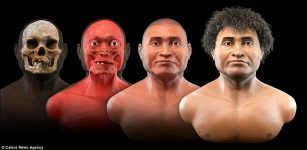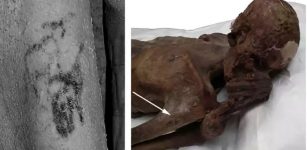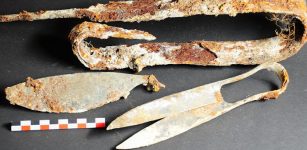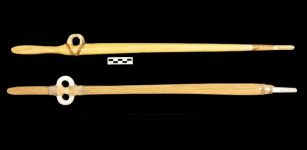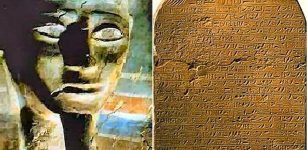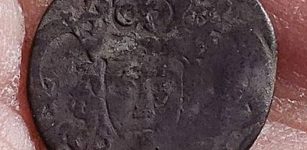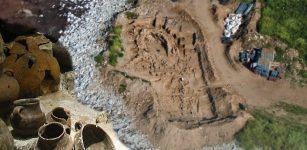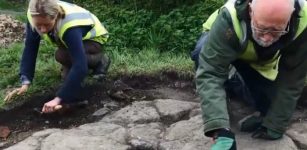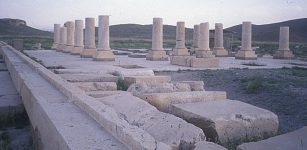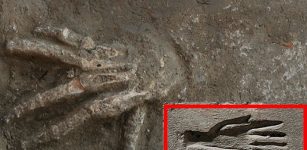New Egyptian Dinosaur Helps To Reconstruct Evolution Of Dinosaurs In Africa
AncientPages.com - A new species of dinosaur Mansourasaurus shahinae, found recently in the Sahara Desert of Egypt, will help to reconstruct the course of dinosaur evolution in Africa, researchers say. Not much is known about Africa’s land-dwelling animals at the end of the Age of Dinosaurs.
The creature’s fossilized remains were unearthed by an expedition undertaken by the Mansoura University Vertebrate Paleontology (MUVP) initiative, an effort led by Dr. Hesham Sallam of the Department of Geology at Mansoura University in Mansoura, Egypt.

Life reconstruiction of the new Titanosaurian dinosaur Mansourasaurus on a coastline in what is now the Western Desert of Egypt approximately 80 million years ago. Credit: Andrew McAfee, Carnegie Museum of Natural History
Mansourasaurus shahinae dinosaur represents a group of sauropods known as titanosaurs. The creature lived on a coastline in what is now the Western Desert of Egypt approximately 80
million years ago.
Mansourasaurus, as one of the few African dinosaurs known from this time period, helps to answer that question. Dr. Sallam and his team analyzed its bones and determined that Mansourasaurus is more closely related to dinosaurs from Europe and Asia than it is to those found farther south in Africa or in South America.
It shows that at least some dinosaurs could move between Africa and Europe near the end of these animals' reign. "Africa's last dinosaurs weren't completely isolated, contrary to what some have proposed in the past," says Gorscak. "There were still connections to Europe."

The left dentary, or lower jaw bone, of the new titanosaurian dinosaur Mansourasaurus shahinae as it was found in rock of the Upper Cretaceous-aged (~80 million-year-old) Quseir Formation of the Dakhla Oasis, Egypt. Credit: Hesham Sallam, Mansoura University
Mansourasaurus belongs to the Titanosauria, a group of sauropods (long-necked plant-eating dinosaurs) that were common throughout much of the world during the Cretaceous. Titanosaurs are famous for including the largest land animals known to science, such as Argentinosaurus, Dreadnoughtus, and Patagotitan. It was moderate-sized for a titanosaur (about 33 feet (10 meters) long) and weighed 5.5 tons (5,000 kg), which similar to a present-day African bull elephant.

Skeletal reconstruction of the new titanosaurian dinosaur Mansourasaurus shahinae from the Late Cretaceous of the Dakhla Oasis, Egypt. Bones shown in color are those that are preserved in the original fossil; other bones are based on those of closely related dinosaurs. Credit: Andrew McAfee, Carnegie Museum of Natural History
Its skeleton is the most complete dinosaur specimen so far discovered from the end of the Cretaceous in Africa, preserving parts of the skull, the lower jaw, neck and back vertebrae, ribs, most of the shoulder and forelimb, part of the hind foot, and pieces of dermal plates.
"Mansourasaurus shahinae is a key new dinosaur species, and a critical discovery for Egyptian and African paleontology," Dr. Eric Gorscak, a postdoctoral research scientist at The Field Museum and a co-author on the study, said in a press release.
Historically, it hasn't been clear how well-connected Africa was to other Southern Hemisphere landmasses and Europe during this time. Interesting is to what degree Africa's animals may have been cut off from their neighbors and evolving on their own separate tracks.
The discovery is described in a study published Monday in Nature Ecology and Evolution.'
Original story - here.
Copyright © AncientPages.com
Expand for referencesReferences:


